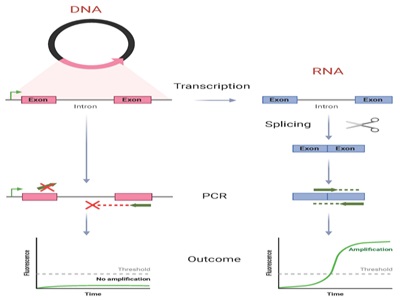Please expect some delays: Our office will be operating at a reduced capacity during the holiday season. Your order might take longer to process and fulfill during this time. Thank you for your patience.
An RNA-Only, Positive Control Target for Clinical Diagnostic Testing
The technology is a robust control system that enables users to readily distinguish between DNA and RNA in bacteria.

What is the Problem?
Clinical diagnostic tests require both negative and positive controls to assess proper assay performance. This has been a challenge for point-of-care tests that detect reverse-transcribed RNA, such as Reverse Transcription Loop-Mediated Isothermal Amplification (RT-LAMP), especially when the tests target bacteria. An appropriate control must confirm successful lysis of bacteria and successful reverse transcription of RNA into cDNA. However, bacteria contains both RNA and DNA and these tests cannot distinguish between detection of RNA versus DNA since they both have the same sequence and can be detected as a native substrate. Thus, there is a need for a control that can distinguish between RNA and DNA to ensure accuracy in clinical diagnostic tests.
What is the Solution?
The solution is a robust control system that enables users to readily distinguish between DNA and its expressed RNA template in bacteria. The innovation consists of an E. coli plasmid that expresses a bacterial antibiotic resistance gene into which a self-splicing intron has been inserted. After transcription, the intron is rapidly and autocatalytically excised from the mRNA, such that the mature mRNA does not contain it. Primers can be designed to flank the self-splicing intron in a configuration that is unable to amplify the DNA target due to its prohibitively large size, but which is able to amplify the RNA template after it has undergone successful splicing, thus achieving specificity for RNA only. Alternatively, primers can be designed to target the intron to specifically identify the presence of DNA, since the self-splicing intron will not be present in the expressed RNA template.
What is the Competitive Advantage?
The competitive advantage of this technology lies in its ability to differentiate between RNA and DNA during clinical testing. This innovation can greatly improve the accuracy of diagnostic tests and is applicable in a wide range of laboratory-based and point-of-care tests clinical molecular diagnostic tests. As the global diagnostic testing market size is valued at $179.9 billion in 2022 with an expected CAGR of 8.6%, there is a significant opportunity for this technology to advance the field of diagnostic and point-of-care testing.